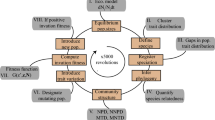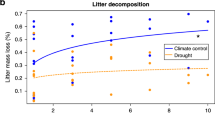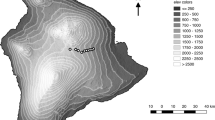Abstract
Competition can profoundly affect biodiversity patterns by determining whether similar species are likely to coexist. When species compete directly for space, competitive ability differences should theoretically promote trait and phylogenetic clustering, provided that niche differences are otherwise minimal. Yet many sessile communities exhibit high biodiversity despite minimal reliance on niche differentiation. A potential explanation is that intransitive competition (‘rock–paper–scissors’ competition) not only promotes species richness but also fosters coexistence among highly dissimilar species with different competitive strategies. Here, we test this hypothesis using a combination of empirical and analytical approaches. In an experimental system comprising 37 wood-decay basidiomycete fungi grown in nutrient-rich agar media, pairwise displacement was maximized when species had widely different competitive traits and divergent evolutionary histories. However, when these interactions were embedded in models of species-rich communities, high levels of intransitivity ultimately overwhelmed the pairwise relationships, allowing the weakest and most dissimilar species to survive. In line with theoretical expectations, these multispecies assemblages exhibited reduced functional and phylogenetic diversity, yet the smallest losses were likewise observed in species-rich communities. By demonstrating that species richness can act as a self-reinforcing buffer against competitive exclusion, these results contribute to our understanding of how biodiversity is maintained in natural systems.
This is a preview of subscription content, access via your institution
Access options
Access Nature and 54 other Nature Portfolio journals
Get Nature+, our best-value online-access subscription
$29.99 / 30 days
cancel any time
Subscribe to this journal
Receive 12 digital issues and online access to articles
$119.00 per year
only $9.92 per issue
Buy this article
- Purchase on Springer Link
- Instant access to full article PDF
Prices may be subject to local taxes which are calculated during checkout




Similar content being viewed by others
References
Hubbell, S. P. The Unified Neutral Theory of Biodiversity and Biogeography (Princeton Univ. Press, 2001).
Kraft, N. J. B., Godoy, O. & Levine, J. M. Plant functional traits and the multidimensional nature of species coexistence. Proc. Natl Acad. Sci. USA 112, 797–802 (2015).
Hutchinson, G. E. Homage to Santa Rosalia, or: Why are there so many kinds of animals? Am. Nat. 93, 145 (1959).
Tokeshi, M. Species Coexistence: Ecological and Evolutionary Perspectives (Wiley, 1999).
Chesson, P. Mechanisms of maintenance of species diversity. Annu. Rev. Ecol. Syst. 31, 343–366 (2000).
Johnson, C. R. & Seinen, I. Selection for restraint in competitive ability in spatial competition systems. Proc. R. Soc. B 269, 655–663 (2002).
Molofsky, J. & Bever, J. D. A novel theory to explain species diversity in landscapes: positive frequency dependence and habitat suitability. Proc. R. Soc. B 269, 2389–2393 (2002).
Amarasekare, P. Interference competition and species coexistence. Proc. R. Soc. B 269, 2541–2550 (2002).
Buss, A. L. W. & Jackson, J. B. C. Competitive networks: nontransitive competitive relationships in cryptic coral reef environments. Am. Nat. 113, 223–234 (1979).
Laird, R. A. & Schamp, B. S. Competitive intransitivity promotes species coexistence. Am. Nat. 168, 182–193 (2006).
Kerr, B., Riley, M. A., Feldman, M. W. & Bohannan, B. J. M. Local dispersal promotes biodiversity in a real-life game of rock–paper–scissors. Nature 418, 171–174 (2002).
Reichenbach, T., Mobilia, M. & Frey, E. Mobility promotes and jeopardizes biodiversity in rock–paper–scissors games. Nature 448, 1046–1049 (2007).
Kirkup, B. C. & Riley, M. a. Antibiotic-mediated antagonism leads to a bacterial game of rock–paper–scissors in vivo . Nature 428, 412–414 (2004).
Violle, C., Nemergut, D. R., Pu, Z. & Jiang, L. Phylogenetic limiting similarity and competitive exclusion. Ecol. Lett. 14, 782–787 (2011).
Macarthur, R. & Levins, R. The limiting similarity, convergence, and divergence of coexisting species. Am. Nat. 101, 377–385 (1967).
Mayfield, M. M. & Levine, J. M. Opposing effects of competitive exclusion on the phylogenetic structure of communities. Ecol. Lett. 13, 1085–1093 (2010).
HilleRisLambers, J., Adler, P. B., Harpole, W. S., Levine, J. M. & Mayfield, M. M. Rethinking community assembly through the lens of coexistence theory. Annu. Rev. Ecol. Evol. Syst. 43, 227–248 (2012).
Chu, C. & Adler, P. B. Large niche differences emerge at the recruitment stage to stabilize grassland coexistence. Ecol. Monogr. 85, 373– 392 (2015).
Kunstler, G. et al. Competitive interactions between forest trees are driven by species’ trait hierarchy, not phylogenetic or functional similarity: implications for forest community assembly. Ecol. Lett. 15, 831–840 (2012).
Hardin, G. The competitive exclusion principle. Science 131, 1292–1297 (1960).
Allesina, S. & Levine, J. M. A competitive network theory of species diversity. Proc. Natl Acad. Sci. USA 108, 5638–5642 (2011).
Jessup, C. M. et al. Big questions, small worlds: microbial model systems in ecology. Trends Ecol. Evol. 19, 189–197 (2004).
Nahum, J. R., Harding, B. N. & Kerr, B. Evolution of restraint in a structured rock–paper–scissors community. Proc. Natl Acad. Sci. USA 108, 10831–10838 (2011).
Hibbing, M. E., Fuqua, C., Parsek, M. R. & Peterson, S. B. Bacterial competition: surviving and thriving in the microbial jungle. Nat. Rev. Microbiol. 8, 15–25 (2010).
Boddy, L. Interspecific combative interactions between wood-decaying basidiomycetes. FEMS Microbiol. Ecol. 31, 185–194 (2000).
Navas, M.-L. & Violle, C. Plant traits related to competition: how do they shape the functional diversity of communities? Community Ecol. 10, 131–137 (2009).
Crowther, T. W. et al. Untangling the fungal niche: the trait-based approach. Front. Microbiol. 5, 579 (2014).
El Ariebi, N., Hiscox, J., Scriven, S. A., Müller, C. T. & Boddy, L. Production and effects of volatile organic compounds during interspecific interactions. Fungal Ecol. 20, 144–154 (2016).
Hiscox, J., Baldrian, P., Rogers, H. J. & Boddy, L. Changes in oxidative enzyme activity during interspecific mycelial interactions involving the white-rot fungus Trametes versicolor . Fungal Genet. Biol. 47, 562–571 (2010).
Maynard, D. S. et al. Modelling the multidimensional niche by linking functional traits to competitive performance. Proc. R. Soc. B 282, 20150516 (2015).
Amarasekare, P. Competitive coexistence in spatially structured environments: a synthesis. Ecol. Lett. 6, 1109–1122 (2003).
Ulrich, W., Soliveres, S., Kryszewski, W., Maestre, F. T. & Gotelli, N. J. Matrix models for quantifying competitive intransitivity from species abundance data. Oikos 123, 1057–1070 (2014).
Kunstler, G. et al. Plant functional traits have globally consistent effects on competition. Nature 529, 1–15 (2016).
Soliveres, S. et al. Intransitive competition is widespread in plant communities and maintains their species richness. Ecol. Lett. 18, 790–798 (2015).
Agren, G. I. & Fagerstrom, T. Limiting dissimilarity in plants: randomness prevents exclusion of species with similar competitive abilities. Oikos 43, 369–375 (1984).
Bastolla, U. et al. The architecture of mutualistic networks minimizes competition and increases biodiversity. Nature 458, 1018–1020 (2009).
Alcántara, J. M., Pulgar, M. & Rey, P. J. Dissecting the role of transitivity and intransitivity on coexistence in competing species networks. Theor. Ecol. http://dx.doi.org/10.1007/s12080-016-0323-y (2016).
Gallien, L. Intransitive competition and its effects on community functional diversity. Oikos 126, 615–623 (2016).
Treseder, K. K. et al. Evolutionary histories of soil fungi are reflected in their large-scale biogeography. Ecol. Lett. 17, 1086–1093 (2014).
Godoy, O., Kraft, N. J. B. & Levine, J. M. Phylogenetic relatedness and the determinants of competitive outcomes. Ecol. Lett. 17, 836–844 (2014).
Jackson, J. B. C. & Buss, L. Alleopathy and spatial competition among coral reef invertebrates. Proc. Natl Acad. Sci. USA 72, 5160–5163 (1975).
Huisman, J., Johansson, A. M., Folmer, E. O. & Weissing, F. J. Towards a solution of the plankton paradox: the importance of physiology and life history. Ecol. Lett. 4, 408–411 (2001).
Huisman, J. & Weissing, F. J. Biodiversity of plankton by species oscillations and chaos. Nature 402, 407–410 (1999).
Vance, R. R. The stable coexistence of two competitors for one resource. Am. Nat. 126, 78–86 (1985).
Vance, R. R. Interference competition and the coexistence of two competitors on a single limiting resource. Ecology 65, 1349–1357 (1984).
Tilman, D. Competition and biodiversity in spatially structured habitats. Ecology 75, 2–16 (1994).
Vandermeer, J. H. The competitive structure of communities: an experimental approach with protozoa. Source Ecol. 50, 362–371 (1969).
Billick, I. & Case, T. J. Higher order interactions in ecological communities: what are they and how can they be detected? Ecology 75, 1529–1543 (1994).
Abrams, P. A. Arguments in favor of higher-order interactions. Am. Nat. 121, 887–891 (1983).
Bairey, E ., Kelsic, E. D & Kishony, R. High-order species interactions shape ecosystem diversity. Nat. Commun. 7, 12285 (2016).
Brazee, N. J & Lindner, D. L. Unravelling the Phellinus pini s.l. complex in North America: A multilocus phylogeny and differentiation analysis of Porodaedalea. For. Pathol. 43, 132–143 (2013).
Crowther, T. W ., Boddy, L & Jones, T. H. Species-specific effects of soil fauna on fungal foraging and decomposition. Oecologia 167, 535–545 (2011).
Crowther, T. W., Boddy, L. & Jones, T. H. Outcomes of fungal interactions are determined by soil invertebrate grazers. Ecol. Lett. 14, 1134–1142 (2011).
Ritchie, F ., McQuilken, M. P & Bain, R. A. Effects of water potential on mycelial growth, sclerotial production, and germination of Rhizoctonia solani from potato. Mycol. Res. 110, 725–733 (2006).
Nesci, A., Etcheverry, M. & Magan, N. Osmotic and matric potential effects on growth, sugar alcohol and sugar accumulation by Aspergillus section Flavi strains from Argentina. J. Appl. Microbiol. 96, 965–972 (2004).
Baldrian, P. et al. Production of extracellular enzymes and degradation of biopolymers by saprotrophic microfungi from the upper layers of forest soil. Plant Soil 338, 111–125 (2010).
Žifčáková, L., Dobiášová, P., Kolářová, Z., Koukol, O. & Baldrian, P. Enzyme activities of fungi associated with Picea abies needles. Fungal Ecol. 4, 427–436 (2011).
Crowther, T. W. et al. Biotic interactions mediate soil microbial feedbacks to climate change. Proc. Natl Acad. Sci. USA 112, 7033–7038 (2015).
Magan, N. & Lacey, J. Effect of water activity, temperature and substrate on interactions between field and storage fungi. Trans. Br. Mycol. Soc. 82, 83–93 (1984).
Evans, J. A., Eyre, C. A., Rogers, H. J., Boddy, L. & Müller, C. T. Changes in volatile production during interspecific interactions between four wood rotting fungi growing in artificial media. Fungal Ecol. 1, 57–68 (2008).
Rao, C. R. Diversity and dissimilarity coefficients: a unified approach. Theor. Popul. Biol. 21, 24–43 (1982).
R Core Team. R: A Language and Environment for Statistical Computing (R Foundation for Statistical Computing, 2017).
Ortiz-Santana, B., Lindner, D. L., Miettinen, O., Justo, A. & Hibbett, D. S. A phylogenetic overview of the antrodia clade (Basidiomycota, Polyporales). Mycologia 105, 1391–1411 (2013).
Katoh, K. & Standley, D. M. MAFFT multiple sequence alignment software version 7: Improvements in performance and usability. Mol. Biol. Evol. 30, 772–780 (2013).
Nei, M. & Kumar, S. Molecular Evolution and Phylogenetics (Oxford Univ. Press, 2000).
Felsentein, J. Confidence limits on phylogenies: an approach using the bootstrap. Evolution 39, 783–791 (1985).
Gascuel, O. BIONJ: an improved version of the NJ algorithm based on a simple model of sequence data. Mol. Biol. Evol. 14, 685–695 (1997).
Tamura, K. et al. MEGA5: Molecular evolutionary genetics analysis using maximum likelihood, evolutionary distance, and maximum parsimony methods. Mol. Biol. Evol. 28, 2731–2739 (2011).
Blomberg, S. P., Garland, T. & Ives, A. R. Testing for phylogenetic signal in comparative data: behavioral traits are more labile. Evolution 57, 717–745 (2003).
Paradis, E. & Claude, J. & Strimmer, K. APE: Analyses of phylogenetics and evolution in R language. Bioinformatics 20, 289–290 (2004).
Kim, J. & Sanderson, M. J. Penalized likelihood phylogenetic inference: bridging the parsimony-likelihood gap. Syst. Biol 57, 665–674 (2008).
Sanderson, M. J. Estimating absolute rates of molecular evolution and divergence times: a penalized likelihood approach. Mol. Biol. Evol 19, 101–109 (2002).
Cadotte, M. W. Experimental evidence that evolutionarily diverse assemblages result in higher productivity. Proc. Natl Acad. Sci. USA 110, 8996–9000 (2013).
Liu, J. et al. Explaining maximum variation in productivity requires phylogenetic diversity and single functional traits. Ecology 96, 140702164956006 (2015).
Cadotte, M. W. & Davies, T. J. Phylogenies in Ecology: A Guide to Concepts and Methods (Princeton Univ. Press, 2016).
Sokal, R. & Michener, C. A statistical method for evaluating systematic relationships. Univ. Kansas Sci. Bull. 38, 1409–1438 (1958).
Elo, A. The Rating of Chess Players, Past and Present (Arco, 1987).
Horn, H. in Ecology and Evolution of Communities (eds Cody, M. & Diamond, J. ) 196–211 (Harvard Univ. Press, 1975).
Crowley, P. H. et al. A general model of local competition for space. Ecol. Lett. 8, 176–188 (2004).
Edwards, K. F. & Schreiber, S. J. Preemption of space can lead to intransitive coexistence of competitors. Oikos 119, 1201–1209 (2010).
Ódor, P. et al. Diversity of dead wood inhabiting fungi and bryophytes in semi-natural beech forests in Europe. Biol. Conserv. 131, 58–71 (2006).
Lindblad, I. Wood-inhabiting fungi on fallen logs of Norway spruce: relations to forest management and substrate quality. Nord. J. Bot. 18, 243–255 (1998).
Cooke, R. & Rayner, A. Ecology of Saprotrophic Fungi (Longman, 1984).
Petraitis, P. S. Competitive networks and measures of intransivity. Am. Nat. 114, 921–925 (1979).
Mouchet, M. A., Villéger, S., Mason, N. W. H. & Mouillot, D. Functional diversity measures: an overview of their redundancy and their ability to discriminate community assembly rules. Funct. Ecol. 24, 867–876 (2010).
Webb, C. O., Ackerly, D. D., McPeek, M. A. & Donoghue, M. J. Phylogenies and community ecology. Annu. Rev. Ecol. Syst. 33, 475–505 (2002).
Clarke, K. & Warwick, R. A taxonomic distinctness index and its statistical properties. J. Appl. Ecol. 35, 523–531 (1998).
de Bello, F., Carmona, C. P., Lepš, J., Szava-Kovats, R. & Pärtel, M. Functional diversity through the mean trait dissimilarity: resolving shortcomings with existing paradigms and algorithms. Oecologia 180, 933–940 (2016).
Helmus, M. R ., Bland, T. J ., Williams, C. K & Ives, A. R. Phylogenetic measures of biodiversity. Am. Nat. 169, E68–E83 (2007).
Acknowledgements
We thank J. Levine and S. Allesina for their comments and discussions on earlier versions of this manuscript, and O. Schmitz, S. Kuebbing, S. Wood and C. Aguilar for their input on initial drafts. We also thank M. Peters for her assistance in the laboratory. This study was partially funded by the Yale Institute for Biospheric Studies (to D.S.M.), the Yale Climate and Energy Institute (to T.W.C), the British Ecological Society (to T.W.C.), the Marie Skłodowska-Curie Actions Fellowship (to T.W.C.), the US National Science Foundation (to M.A.B., T.W.C. and D.S.M., DEB-1601036, DEB-1021098 and DEB-1457614) and the US Forest Service.
Author information
Authors and Affiliations
Contributions
D.S.M. conceived the study, collected and analysed the data, and prepared the manuscript. T.W.C. and M.A.B. contributed equally to the study; T.W.C. helped to design the experiments, collect data and assist with manuscript preparation; M.A.B. assisted with the study design, conceptual advances and manuscript preparation; L.T.A.v.D. and S.D.F. performed enzyme analyses and supplied analytical tools; J.A.G. and D.L.L. provided fungal cultures, collected fungal trait data, and conducted DNA and phylogenetic analyses. All authors discussed the results and commented on the manuscript.
Corresponding author
Ethics declarations
Competing interests
The authors declare no competing financial interests.
Supplementary information
Supplementary Information
Supplementary Tables 1–9, Supplementary Figure 1 (PDF 391 kb)
Rights and permissions
About this article
Cite this article
Maynard, D., Bradford, M., Lindner, D. et al. Diversity begets diversity in competition for space. Nat Ecol Evol 1, 0156 (2017). https://doi.org/10.1038/s41559-017-0156
Received:
Accepted:
Published:
DOI: https://doi.org/10.1038/s41559-017-0156
This article is cited by
-
Bayesian analysis of biodiversity patterns via beam trawl versus video transect—a comparative case study of Svalbard rhodolith beds
Biodiversity and Conservation (2024)
-
Changing litter composition following the dual invasion of Amur honeysuckle and the emerald ash borer alters fungal driven decomposition in Midwestern forests
Biological Invasions (2023)
-
Network structure of resource use and niche overlap within the endophytic microbiome
The ISME Journal (2022)
-
Multiple drivers and lineage-specific insect extinctions during the Permo–Triassic
Nature Communications (2022)
-
Allophlebia, a new genus to accomodate Phlebia ludoviciana (Agaricomycetes, Polyporales)
Mycological Progress (2022)



